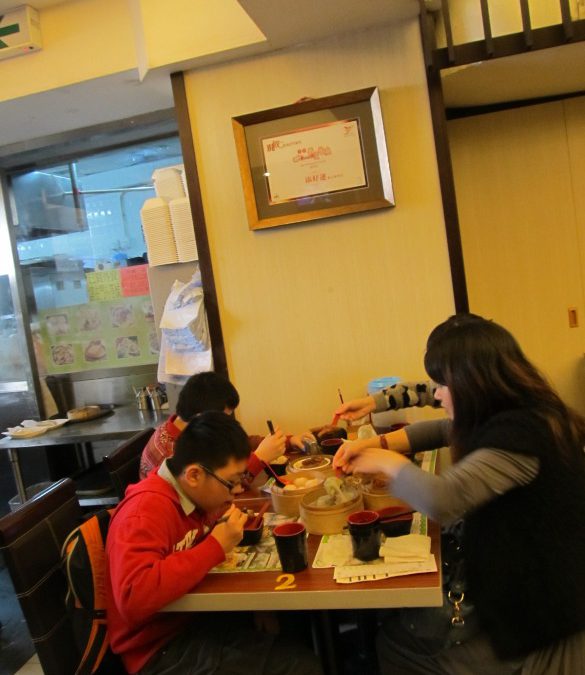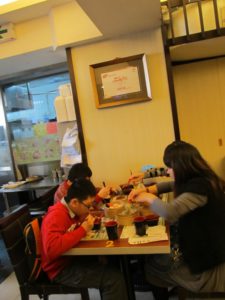A prominent food magazine editor wrote recently about traveling to a far flung destination just for a great meal. I guess that’s a more common practice among foodies than you might think. I can relate.
Take my recent trip to Hong Kong. I can’t say food is what prompted me to fly 15 hours around the world. But while I was there, I certainly was determined to eat my way through the amazing and varied cuisine.
Unfortunately, locals say it would take 50 years to sample all the restaurants in Hong Kong.
I’ve only got a few days and I’m determined to eat my way through this huge city.
Today, I’m the only Caucasian face in the jam-packed Tim Ho Wan that has the reputation for being the cheapest Michelin star restaurant in the world. People come here for Dim Sum and are lined up waiting outside.
“We don’t like to make reservations in Hong Kong,” says my guide Wing Lau, who grew up in Hong Kong and has lived here her entire life. “Waiting is part of the experience. “We chat.”
This simple place with the paper place mats and a plastic jug of tea on the table and waiters rushing with the baked buns with BBQ pork that this place is famous for, the steamed fresh shrimp and pork dumplings, the noodles.. I learn only later that is a hot meal ticket because of the chef and the Michelin star.
There are tables of multi-generational families and tables of friends. This isn’t a place to linger—“We eat and we go,” says Lau.
She also says Dim Sum is something natives can’t live without and can’t really cook at home. Take the Glue rice dumpling—rice filled with shrimp, chicken and pork and then wrapped in a leaf and steamed. Delicious! There is a homemade “rice roll” that melts on the tongue but my favorite is the baked BBQ bun—so fresh, salty and sweet at once.
Everyone shares everything. We have tonic medlar and petal—kind of an orange yellow with seeds that I’m told are good for the eyes. This place serves Dim Sum from 8 a.m. until 10 p.m. and is always busy – and incredibly cheap—the two of us eat until we can’t eat anymore for $14.
Later for lunch and dinner we sample diametrically different Hong Kong culinary experiences. For lunch, we head to a historic Chinese Heritage Building in Hong Kong that has been transformed from a turn of the century pawn shop to an oh-so-hip British restaurant called of course The Pawn where the menu changes daily and we feast on oysters flown in from Scotland, whole roast Dover sole with tarragon and dill breadcrumbs, honey glazed carrots and yummy fries with garlic mayo and finished with sticky toffee pudding and ice cream. Yummy and so very British though the crowd was mostly Asian.
For dinner, we took a culinary journey to Shanghai and one of Hong Kong’s most famous Shanghai style restaurants Xiao Nan Guo Premier (high up in a building on the Kowloon side) where we feast on three different kinds of soup (hot and sour, fish soup, steamed pork dumplings) that melt in your mouth, sweet and sour spareribs, pickled cucumber drunken chicken served cold and marinated in sweet Chinese rice wine work fried huge prawns…spring rolls, wok fried rice cake…each was elegantly displayed and oh-so-good.
Another day, we’ve gone Northeast from Kowloon into the outer territories and are sitting outside at Chuen Kee Seafood Restaurant in Sai Kung, a small city of about 150,000 people as dish after dish of fresh seafood is brought to our table—lobster on top of noodles, fried squid, abalone, steamed fish, stir fried crab with ginger and scallions.
The restaurant is packed because it is the weekend. Before we ate, we ogled some two dozen tanks of fresh fish and seafood—lobsters (some from as far as Boston, sad to say) scallops, big Conch, Long clams and pearl clams and sea urchins and varieties of lobsters I’ve never seen. Our feast is just roughly $22 each USA. We’re surprised to learn that the fish comes from so far away—Australia the UK, the USA but with so many people living in Hong Kong and 2 million tourists a month from China, there simply aren’t enough fish in the sea here.
When people say they eat their way across Hong Kong, I understand it now. I ask our guide Wing Lau, if the Chinese tourists—millions every month–opt for Western cuisine but she says not typically, in part because they don’t have the patience for long drawn out meals. “They’ll eat nine courses in an hour and a half,” she jokes.
Though still jet lagged after the 15-hour flight, I’m trying to get a sense of this amazing place—7 million people living in an area roughly half the size of Rhode Island packed with every variety of store and restaurants.
Green space in this crowded city is prized. We go to Nan Lian Garden in which I learn every hill, rock body of water, plant and timber structure was placed according to the methods of the ancient style of the Tang dynasty. “We don’t have too many gardens,” she notes. “We do our gathering in restaurants.”


